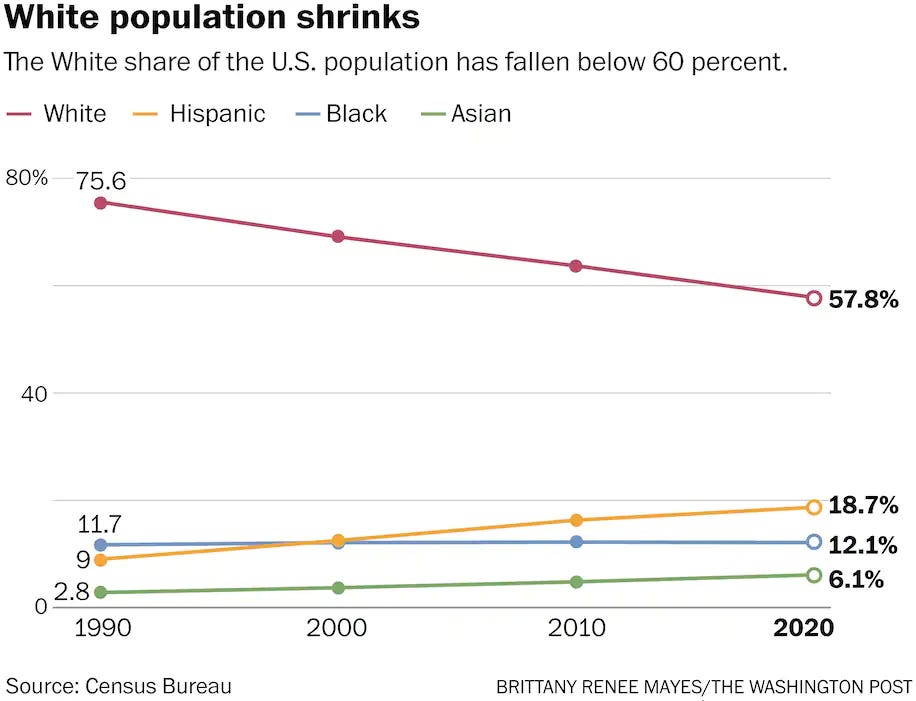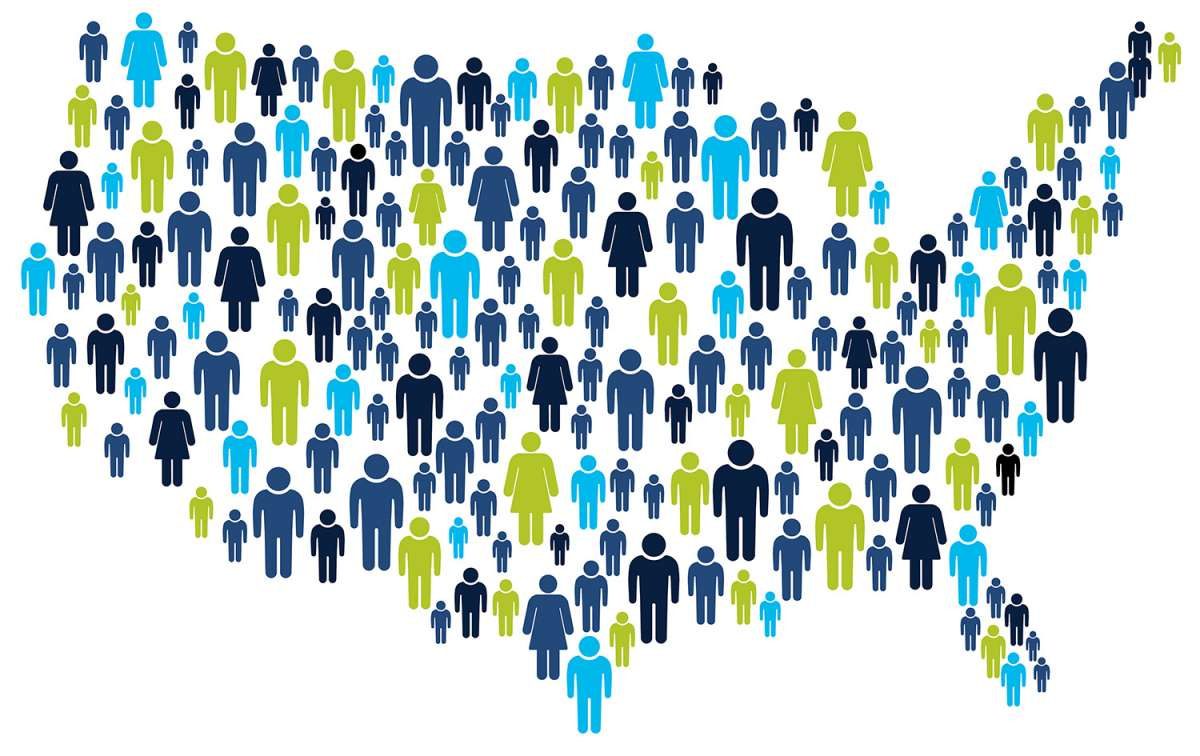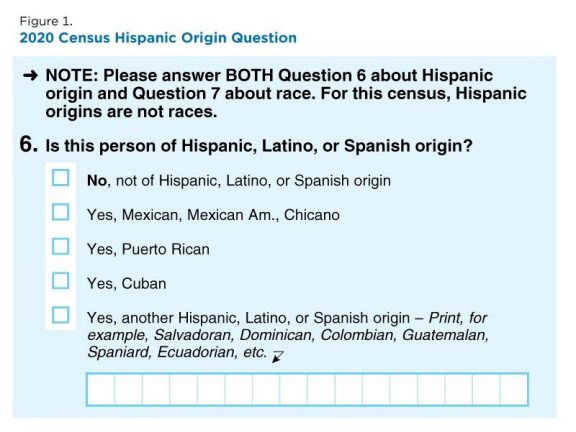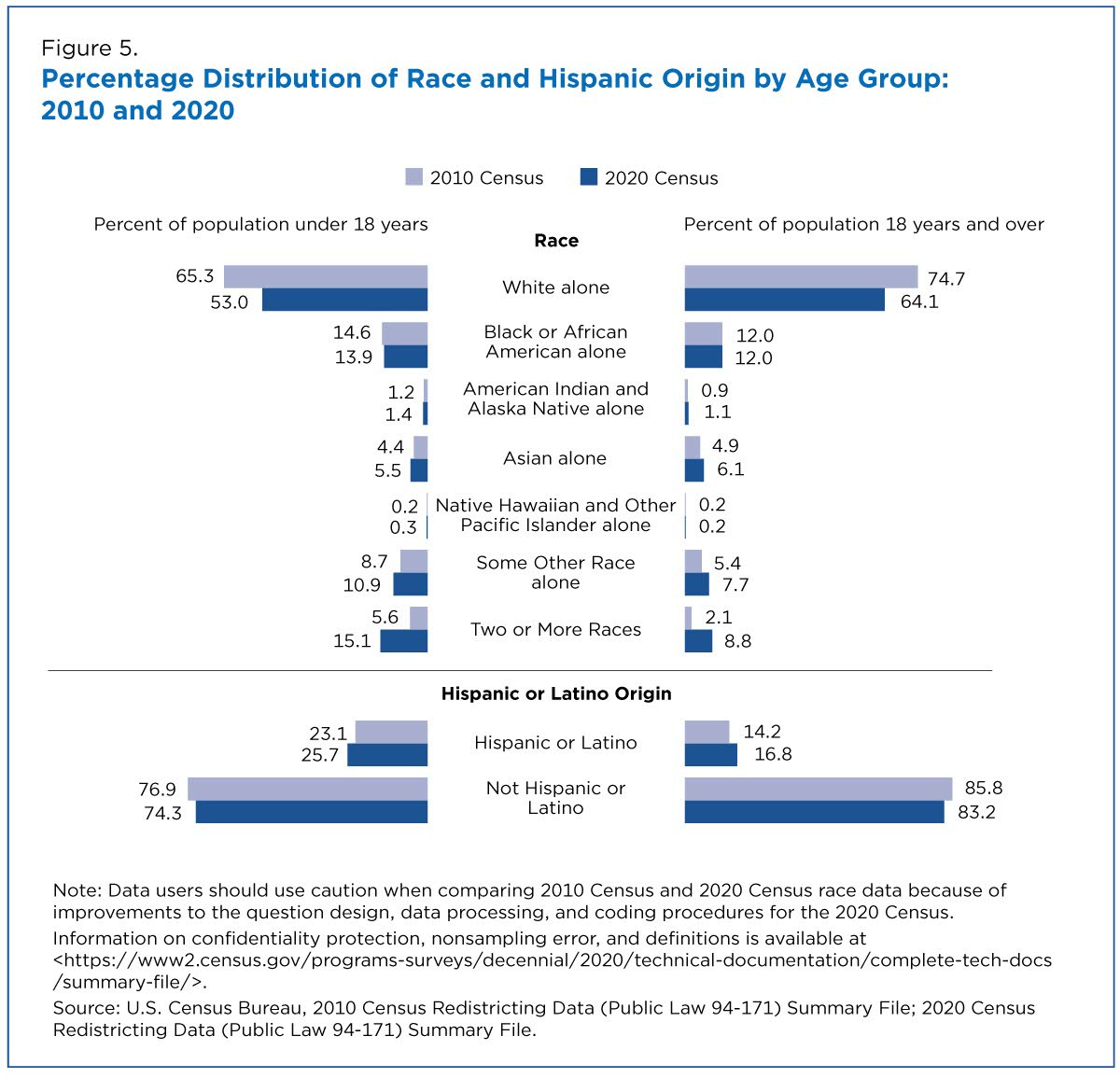Demographic destiny, or dangerous delusion?
Progressives salivating over the census data urgently need to see themselves through the eyes of extremists—and read the fine print.
America, it’s time for a family meeting. We got a cool data dump last week! The U.S. Census Bureau shared a mountain of detailed demographic data resulting from last year’s census. This data is critical for state governments who are about to embark on redistricting efforts, and includes neighborhood-level information about population changes over the last decade. In order to comply with voting rights laws, this data must also include the detailed racial breakdown of these populations. The headline takeaway was that the number of Americans who self-identify as white went down, while those who identify as black stayed roughly flat, and those who identify as Hispanic or Asian went up. The way-too-over-simplified gist looks something like this:

It’s definitely interesting and worth talking about! But let’s take a step back first.
You see, when you live in a country where your fellow countrymen have been doing things like this:
…oh, and this:
…it’s ill-advised to go around casually saying things like this:


… or, for that matter, write suggestive yet information-less headlines like this:
It was obvious to Matt Yglesias where this was headed.

Imagine that! I’ll go a step further. If one genuinely wants to “end racism,” is concerned about rising hate and extremism on the right, and wants to reduce the number of people who adopt or perpetuate white nationalist and white supremacist philosophies, you absolutely must educate yourself on “replacement theory.” Simply put, it’s the idea that we progressive “elites” are conspiring to push for liberalized immigration policies with the specific goal of increasing the number of non-white people in America, as well as pushing affirmative action policies to reduce the power of the white people already in America, all in order to “replace” whites as the dominant force in American power structures and culture. In the extreme, the fear is that whites will not just have less power, but none; not just a smaller population, but total “genocide.”
Unsurprisingly, Jennifer Rubin’s tweet was catnip, and another Matt took the bait!
Go ahead and watch 33:00-36:25, or read the transcript that MMFA did in fact capture. Matt Walsh wraps by asking us on the left some questions that I will now attempt to answer in quick-fire fashion:
So do you not want to replace white people? Me personally? No. (Also I am one, and I made another one.)
Are you saying that you don't want that? See #1.
You don't want to replace white people in the population with a great portion of non-white people, you don't want to replace white people in universities and positions of power, you're saying you don't want that? Again, not particularly, no.
Because while you condemn replacement theory as a white supremacist, you know, conspiracy theory, I notice you don't deny it. I mean, you don't come out and say 'oh no, we don't want to do that.' But if you don't, then just – say so. Um, ok! “Oh, no, we don’t want to do that.”
And then we're going to have some follow-up questions about, like, okay then what's going on down here at the border and why do we have these affirmative action policies in place? Two different questions, each worthy of longer conversations. “At the border” is a complex international issue that we’re trying to resolve through investment in the Northern Triangle and an attempt to counter false messaging about the ease of asylum claims, and in the meantime “expelling most single adults and families,” all while attempting to treat people humanely. (It’s hard!) Affirmative action has been debated for decades, and even the left is sharply divided. There is a lot of misinformation about what affirmative action policies are legal in different venues (it’s typically just focused on recruiting), but at the end of the day, for all its faults, its goal increasing opportunities for people from communities that have historically had fewer of them. Anyway, it’s complicated!
And why are you popping champagne and throwing confetti when there are reports saying there are fewer white people? I’m not, but I’m sure some people are and I agree that it is a dumb thing for people to do!
Now, Walsh is not a figure I particularly enjoy hearing from, nor have I seen much of his content, but I do not suspect him of being a closet white supremacist or white nationalist. (Tucker… is debatable.) In this case, Walsh is actually raising a thought-provoking point. While Jennifer Rubin’s single tweet might be the most explicit celebration of the demographic shifts to come from a media figure, I am quite sure many on the left openly celebrated the results, in no small part out of schadenfreude at the imagined dismay of racist white conservatives. (In an interesting twist, Charles Blow inadvertently describes a sort of reverse replacement theory, where it is conservative elites who are plotting to minimize the minority population.) However, like Tucker, Walsh consciously chooses to dump gasoline on the very real fire of white nationalists and white supremacists who may feel existentially threatened by the idea of a “browning” America—some of whom have committed acts of violence in the past few years in response to these threats. One does not have to choose which group is more to blame for our current predicament to be concerned about both responses. What we end up with is almost another example of the horseshoe effect, where both extremes have reached morally and logically flawed stances for extremely similar reasons.
To be clear: I believe that cheering about a reduction in the white population is wrong, and despairing over an increase in the non-white population is wrong. Assigning moral weight to a person or group based solely on which box(es) they check on the census survey is wrong. In the eternal words of James Baldwin, despite the “political reality” of race, “the value placed on the color of the skin is always and everywhere and forever a delusion.”
Wait!, you might say. The left is only cheering a country that’s more racially integrated and welcoming of minority groups! The right is just upset about unregulated immigration! That could be true, but none of that is actually revealed by the census data (and sounds more like post-hoc rationalization to me, anyway). The only thing revealed by the census data was that the number of people who self-identify as “white alone” went down, and the number of people who self-identify with other racial or ethnic groups, alone or in combination, went up. And if you have a strong emotional reaction to racial data alone, well, we used to have a word for that.
So, no, I do not want Rubin or Walsh pouring fuel on the fire of far right extremists who are afraid that white people are going extinct—especially when that’s not even what’s happening.
Buried in most of the news coverage, if mentioned at all, is this important fact from the Census Bureau: they redesigned the question format to such an extent that they stated,
We are confident that differences in the overall racial distributions are largely due to improvements in the design of the two separate questions for race data collection and processing as well as some demographic changes over the past 10 years.
…
The observed changes in the White population could be attributed to a number of factors, including demographic change since 2010. But we expect they were largely due to the improvements to the design of the two separate questions for race and ethnicity, data processing and coding, which enabled a more thorough and accurate depiction of how people prefer to self-identify.
You read that right—it’s quite likely that the population we think of as “white” did not change significantly in size at all! You may recall that the census does not officially consider “Hispanic” to be a race. Respondents are first asked whether they identify as being of Hispanic, Latino, or Spanish origin or not, and to list which specific countries of origin apply.
They are then asked to select a “race,” where choices are limited to white, black, Native American, then, mysteriously, one of several specific Asian or Pacific Island countries of origin (including “Chamorro,” which I had to Google) as opposed to a blanket “Asian” or “AAPI” category, followed by “Some other race.” No “Hispanic” categories at all, nor any unique callout for people of Middle Eastern or Northern African (MENA) origins. People of Egyptian or Irish heritage are all the same “race,” but people of Korean or Japanese ancestry appear to be two unique “races.” People of Mexican or Spanish or other Hispanic origins are invited to choose their own adventure; some choose white, some choose black, but more and more just list it under “some other race.”
It’s worth observing how out-of-step even the improved questions are with our modern, commonly assumed but under-examined, racial buckets. (It’s also interesting to trace the history of how race has been tracked on the census—a Grand Tour of American Racecraft.) When asked how they define race, the Census Bureau responds, “The racial categories included in the census questionnaire generally reflect a social definition of race recognized in this country and not an attempt to define race biologically, anthropologically, or genetically.” So their goal really is just to reflect what Americans think about themselves. They conducted extensive research into this subject in the mid-2010s and ended up recommending several major changes: combining the Hispanic origin and race questions into a single race & ethnicity question, as well as creating a separate MENA racial category. However, the U.S. Office of Management and Budget (OMB) under Trump did not act on their recommendations and the Bureau was stuck with the strange constraints issued by the OMB in 1997. The proposed changes are expected to be implemented in time for the 2030 Census, when we can expect to yet again clutch our pearls or pop champagne over demographic shifts that are mostly illusions.
So how did this happen? The largest changes in 2020 that seem to have affected the “white alone” and “black alone” counts were that the instructions were updated from “Mark [X] one or more boxes” to “Mark [X] one or more boxes AND print origins,” and that space was provided for specific countries of origin for white or black racial selections. The extra steps seem to have led more people to actually read the instructions, realize that they even had the option to select multiple races, and choose to do so, resulting in a significant (276%) rise in people choosing a two or more racial categories. Per the Bureau, “The “in combination” multiracial populations for all race groups accounted for most of the overall changes in each racial category.”
Throughout it all, the Bureau’s press releases make it very clear that diversity has not actually changed significantly; it’s that we are more accurately capturing the racial diversity that was already here. Contrast that with the Washington Post’s breathless claims:
The opioid epidemic and lower-than-anticipated birthrates among millennials after the Great Recession accelerated the White population’s decline, said William Frey, a demographer at the Brookings Institution.
“Twenty years ago if you told people this was going to be the case, they wouldn’t have believed you,” he said of the White decline. “The country is changing dramatically.”
Why are progressives so eager to believe something that is patently not true? It’s simple, really: partisanship. There’s a widespread adage that some Democrats cling to like a security blanket: “demographics are destiny,” the idea being that as the nation gets more “brown” and less “white,” our politics will become more progressive, because everyone knows that conservatives are virulently racist, repelling non-white voters and relying almost exclusively on white voters. Progressives just need to wait for the white Greatest Generation and Baby Boomers to kick the bucket, then eternal electoral victory will be ours! Well, besides being morbid and arguably racist, that philosophy is just flawed. The Democratic strategists who first popularized the concept, Ruy Teixeira and John Judis, authors of the 2002 book The Emerging Democratic Majority, have repeatedly tried to clarify this laissez faire, self-righteous approach not only misses the point, but is backfiring, as their vision required a multiracial, working class coalition. Instead, conservatives managed to increase their appeal to working class voters of all racial groups throughout the Trump years, including formerly reliable Democrats, as Democrats drove them away with faculty lounge wokeness.
For data nerds and political hobbyists alike, the census data dump was like Christmas morning. It’s fascinating to see how the country is changing—where people are choosing to live, how we’re getting older, how we’re changing the ways we see ourselves and who we choose to build lives with. A society where race is less of a factor in whom we choose to welcome as immigrants, in whom we choose to marry and start families with, in whom we choose to live next door to—this society is a better society. But the census data does not tell as much as we think it does—our reactions to it tell us more. And a society where we gloat or rage about whether our racial “team” got bigger or smaller is a worse society.









Three cheers for your last paragraph.
I'm reading TCW's Self Portrait in Black and White right now and I find it beautiful and calming, though it's on this very fraught subject. I can't help but feel like all this is so dumb. I'm a very pale person but didn't know it until my first winter in Chicago after a childhood in Southern California.
After a week at the beach, my skin is several shades browner than it was in late July. Skin color culture, country of origin: all interesting, but only have the value we invest them with.
I'm having some trouble reconciling the graph of 1990-2020 and the text assertion that nothing much is really changed demographically between 2010 and 2020.
As best I understand your point, the changes from 1990-2000, and from 2000-2010 are real demographic changes, but the change from 2010 to 2020 is almost totally an illusion created by changes in the questions between those latter years.
And it's purely random coincidence that every line on the chart is pretty linear through all 4 data points, even though the changes between the first three points is due to real demographic differences, and the remarkably similar changes in the final points are due to methodological not demographic differences.
And that there was some unexplained factor occurring around 2010 which caused long term historical trends to stop and be replaced by essentially flat lines of relatively constant demographics since then (masked by methodological changes which falsely appeared to continue the long term trends).
Does this not raise any questions that need further exploration for you as an analyst, before taking it as established fact to build arguments upon? Like do birth and death rates and family sizes or immigration rates, show a striking knee around 2010 which could explain the asserted flattening of the long term trends since then?
I am not expressing alarm nor excitement at demographic changes (or the omission thereof), just finding that the assertions made seem to need more serious explanation than just textual expressions of subjective "confidence", an interpretation or speculation which could potentially be affected by socio-political bias. Where is the evidence of *data* changes in the underlying drivers mentioned above, which could explain the (allegedly obscured) 2010ish flattening of longer term trends (going back even before 1990)?